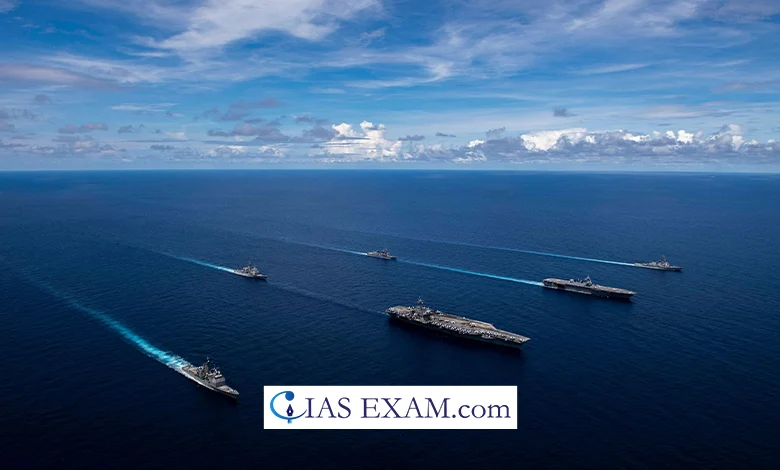India’s Strategic Approach in the South China Sea
GS Paper 2 - International Relations

Context
Recently, India’s External Affairs Minister articulated India’s full support for the Philippines in upholding its national sovereignty, in a joint statement during his visit to Manila.
A joint statement in 2023 between India and Philippines had also called for China to adhere to the rules-based maritime order and acknowledge the International Court of Justice (ICJ) ruling of 2016 in favor of the Philippines. Both these statements are part of an evolving approach that signals a departure from India’s earlier more cautionary and neutral position vis-à-vis the South China Sea.
South China Sea and its Importance
- The South China Sea is an arm of western Pacific Ocean in Southeast Asia. It is south of China, east & south of Vietnam, west of the Philippines and north of the island of Borneo.
- Bordering states & territories (clockwise from north): the People’s Republic of China, the Republic of China (Taiwan), the Philippines, Malaysia, Brunei, Indonesia, Singapore and Vietnam.
- It is connected by Taiwan Strait with the East China Sea and by Luzon Strait with the Philippine Sea and contains numerous shoals, reefs, atolls and islands. The Paracel Islands, the Spratly Islands and the Scarborough Shoal are the most important.
- This sea holds tremendous strategic importance for its location as it is the connecting link between the Indian Ocean and the Pacific Ocean, through Strait of Malacca.
- According to the United Nations Conference on Trade And Development (UNCTAD) one-third of the global shipping passes through it, carrying trillions of trade which makes it a significant geopolitical water body.
- According to the Department of Environment and Natural Resources, Philippines, this sea has one-third of the entire world’s marine biodiversity and contains lucrative fisheries providing food security to the Southeast Asian nations.
- It is one of the world’s most heavily trafficked waterways. An estimated USD 3.4 trillion in ship-borne commerce transits the sea each year, including energy supplies to the U.S., Japan and South Korea.
Disputes over South-China Sea
- China, Taiwan, and Vietnam compete over sovereignty over the Paracel Islands, which China has controlled since 1974. The PRC and Taiwan both claim Pratas Island, which Taiwan currently holds.
- In the southern section of the sea, China, Taiwan, and Vietnam each claim all of the approximately 200 Spratly Islands, while Brunei, Malaysia, and the Philippines claim some. Vietnam has the most land characteristics in the island chain, whereas Taiwan has the greatest.
- The United States and the majority of other nations view UNCLOS as granting coastal governments the power to control economic activity inside their EEZs but not the right to regulate navigation and overflight through the EEZ, including military ships and aircraft.
- In 2016, a UNCLOS arbitral tribunal ruled, among other things, that China’s nine-dash line claim had “no legal basis” and that China violated the Philippines’ sovereign rights by interfering with Philippine vessels, causing environmental damage, and engaging in reclamation work on a feature in the Philippines’ EEZ.
- Between 2013 and 2015, China carried out massive land reclamation (i.e., island-building activities) in the SCS’s Spratly Island chain. China holds seven contested locations, and the reclamation generated around five square miles of artificial landmasses.
India’s Shifting Stand in the South China Sea Dispute
- In July 2016, after the arbitral tribunal issued its decision in a lawsuit brought by the Philippines questioning China’s actions and rights in the South China Sea, India simply stated that it took notice of the verdict. This was most likely done to avoid taking sides, as China has repeatedly rejected the ruling as “illegal” and refused to acknowledge the tribunal’s legitimacy.
- However, in 2020, India modified its attitude and, along with the Philippines, emphasized the importance of peaceful conflict resolution and adherence to international law. This is the first time India has advocated complying with the award, marking a substantial shift in India’s “neutral” attitude on the South China Sea conflicts.
- For the first time in May 2019, the Indian Navy participated in joint drills with the United States, Japan, and the Philippines in the South China Sea. One year later, in August 2021, the Indian Navy conducted military drills with the navy of Vietnam, the Philippines, Malaysia, Australia, and Indonesia.
- India has also significantly increased its military sales and assistance to the Philippines and Vietnam. In January 2022, India reached a deal with the Philippines for the export of 100 BrahMos supersonic anti-ship missiles.
Reasons for Shifting Stance
- Strategic interests, freedom of passage, and oil and gas resources are the three causes that drive India’s increased participation in the South China Sea. Geographically, Southeast Asia serves both India’s backyard and a doorway to the Indian Ocean.
- India’s policy direction has shifted from Look East to Act East under the current government, indicating a more strategic and active involvement with the Indo-Pacific region.
- Given that half of India’s international commerce goes via the Malacca Strait, open and safe passage in the South China Sea is critical to its trade security. This is another reason why India participated in the South China Sea conflict, despite having no maritime issues with China or the ASEAN nations.
- The United States is a “pull factor” that urges India to get engaged in the South China Sea issue. Both countries share many mutual interests. Both are pillars of the Quad, which seeks to create a rule-based global order. Both are worried about China’s influence in the South China Sea, and they have similar viewpoints on the conflicts.
- The ASEAN centrality in India’s Indo-Pacific strategy also makes it imperative for India to buttress the ASEAN position, though differences within the regional grouping continue to pose a challenge to such endeavors.
Way Forward
India is expected to deepen its participation in the South China Sea through numerous ways, which would generate concern in China. However, India’s impact in these issues is limited. Unlike the US, India lacks significant connections and a military presence in the South China Sea, which will inevitably restrict its direct engagement. Furthermore, India’s prime objective is to preserve its supremacy in the Indian Ocean rather than to replace China in the South China Sea.
SOURCE: The Hindu





.png)



